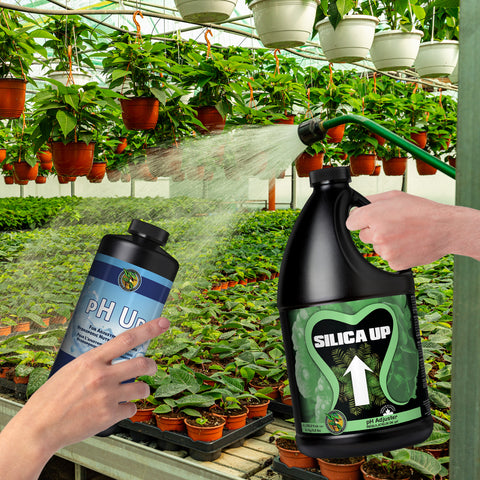The Growers Guide to pH Adjusters

Sorting out what to use to adjust your pH can be daunting for the best of cannabis growers, especially since it’s a delicate balance between efficiency and safety.
That’s why we’ve created a breakdown of the various pH choices to help you and your buds out.
Keep in mind, when it comes to pH adjusters--
Always read the SDS beforehand and take proper safety precautions.
Safety is paramount, especially since a few of these products can cause severe injury.
With that said, let’s dive in.
pH Downs
Hydrochloric Acid
- This is a very common and inexpensive acid.
- Typically found in the 30-32% range, since it's impossible to produce in liquid form at higher concentrations.
- It adds chloride ions (micro nutrients) to the plants which in small doses are beneficial, however in larger amounts can contribute to EC/TDS levels (Electrical Conductivity/Total Dissolved Solids) without much benefit.
- In an emergency this could be used, as it will drop pH levels effectively. That said, it’s not recommended.
Warning
This acid easily evaporates, so a proper breathing apparatus is necessary for anyone handling it.
Nitric Acid
- Expensive and tightly regulated by the government.
- A nice bonus is that plants utilize the nitrogen from the acid.
- If using, make sure to test levels consistently to ensure it doesn't get too high.
- Potentially useful for growing in hardwater conditions.
Warning
Extremely dangerous to handle, as it readily fumes. It is also a strong oxidizer (will provide oxygen to fire) so always be cautious when handling.
Sulfuric Acid
- Quite effective at dropping pH levels.
- Plants will readily use the sulfur, which is hard to overdose on.
Warning
Very dangerous. It has a high affinity for water and can cause it to boil and splatter when mixed, which may lead to chemical burns.
Phosphoric Acid
- The most commonly used pH down in the hydroponic industry, it will provide an extra source of phosphorus to a nutrient solution.
- While considered to be a dangerous good, it doesn't have the same fuming, oxidation, or heat issues as the previously mentioned acids. That said, don't let this fool you, take proper precautions when using.
Warning
- Can be problematic when used with hard water as it may induce fallout.
Organic Acids
- The most common are acetic, lactic, and citric acids. Citric being the safest and most effective.
- These aren't as strong as other acids, so you’ll need to use more and adjust frequently.
- Not considered dangerous goods and can be shipped in the mail.
- Won't have a major impact on EC/TDS.
- Vinegar contains acetic acid, and lemon juice contains citric. These can be used in an emergency for pH adjustment.
Low pH Salts
- The most common are Monopotassium Phosphate (MKP) and Monoammonium Phosphate (MAP). MAP being the stronger of the two.
- Not as effective as some of the strong acids previously mentioned, and because of this, it requires a larger dosage, which in turn, pushes up the EC/TDS.
- Keep in mind these are granular so some growers find them less convenient.
pH Ups
*Note: only includes sources that could be used in hydroponics.
Also, each adjuster listed here has a sodium version, but those will add EC/TDS without any nutritional value.
Potassium Bicarbonate
- This is very safe to use and is not listed as a dangerous good.
- It has a weak base, which means that larger amounts are needed for adjustment compared to others.
- The bicarbonate ion has high buffering potential. This can be good or problematic, depending on where it decides to buffer.
Potassium Silicate
- An effective "middle of the road" pH adjuster, that gives you a good pH boost without the intensity of something like hydroxide.
- While silicate isn't an essential plant nutrient, it does come with some added bonuses in strengthening the plant.
- If safety is a priority, these are some of the best options when it comes to pH.
- Can be shipped by post.
Warning
- Ensure it does not dry out. If it does, the shards are glasslike and can become a safety hazard.
Potassium Hydroxide (Caustic Potash)
- Works extremely well in raising pH levels. Easily the best option for effectiveness.
Warning
- Very dangerous and can only be shipped as a dangerous good. Take proper precautions when handling.
Ammonia
- Seldom used due to the strong smell.
- Depending on the concentration is potentially dangerous.
- It will add nitrogen to a nutrient solution.
For pH adjuster's that are safe and good for shipping, try Future Harvest's Silica Up and Citric Down.
And if you're looking for the ideal pH levels for your cannabis we recommend anywhere between 5.8 and 6.2.






